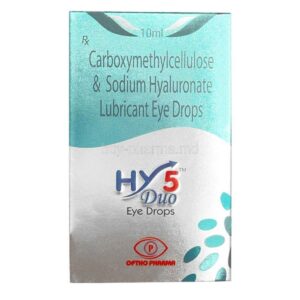CARBOXYMETHYL CELLULOSE (CMC) + LUBRICATING EYE DROPS
Carboxymethyl Cellulose (cmc): Carboxymethyl Cellulose (CMC), also known as Sodium Carboxymethyl Cellulose, is a medication commonly used as an eye lubricant. It is available in the form of eye drops and ointments and helps to relieve dryness and discomfort in the eyes.
The main mechanism of action of CMC is its ability to increase the viscosity of tears, providing a lubricating and protective effect on the surface of the eye. It forms a film on the cornea, reducing friction and preventing further damage to the eye. CMC also helps to retain moisture and stabilize the tear film.
The usual recommended dose of CMC eye drops is 1 to 2 drops in the affected eye(s) as needed, or as directed by a healthcare professional. CMC eye ointment is typically applied 1 to 3 times daily or as instructed by a doctor.
Most patients tolerate CMC well, but some may experience mild side effects such as temporary blurred vision or eye irritation. These side effects are usually temporary and resolve on their own. However, if any serious side effects, such as eye pain, swelling, or redness, occur, it is important to seek medical attention.
It is worth noting that the safety of CMC during pregnancy or breastfeeding has not been well established. Therefore, it is advised to consult with a healthcare professional before using this medication in such situations.
In summary, Carboxymethyl Cellulose is a medication used to relieve dryness and discomfort in the eyes. It works by increasing the viscosity of tears, forming a protective film and reducing friction. The typical dose is 1 to 2 drops of eye drops or a small amount of eye ointment, and side effects are generally mild and temporary.
Lubricating Eye Drops: Lubricating Eye Drops, also known as artificial tears, are over-the-counter medications used to relieve dryness and irritation in the eyes. They are commonly used for conditions such as dry eye syndrome, environmental factors (such as smoke or wind), prolonged computer use, or contact lens wear.
The primary mechanism of action of Lubricating Eye Drops is to provide moisture and lubrication to the eyes. They mimic the natural tears found in the eyes and help maintain the eye’s moisture balance. These drops typically contain ingredients like electrolytes, oils, and polymers to provide sufficient lubrication and improve tear stability.
The dose of Lubricating Eye Drops varies depending on the product, so it is essential to read and follow the instructions provided by the manufacturer. Generally, one or two drops can be instilled into each affected eye as needed, which is typically a few times a day. However, individual needs may vary, and it is advisable to consult with a healthcare professional if you have any questions regarding specific dosing.
Lubricating Eye Drops are generally well-tolerated, with minimal side effects. However, some individuals may experience mild eye irritation or allergic reactions, such as redness, itching, or swelling. If these side effects persist or worsen, it is essential to discontinue use and consult a healthcare professional.
It is worth mentioning that Lubricating Eye Drops are for symptomatic relief and may not treat the underlying cause of dry eye syndrome or other eye conditions. If symptoms persist or worsen over time, it is recommended to consult a healthcare professional for a proper diagnosis and treatment plan.

